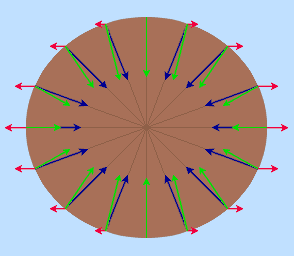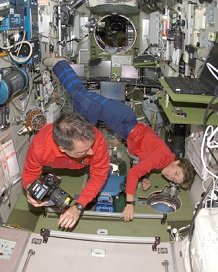
 Which Way Is Down?
Which Way Is Down?Earth is an oblate spheroid. The centrifugal effect makes it bulge toward the equator and shrink on the polar axis, so the equatorial diameter is about 43 kilometers (27 miles) greater than the polar diameter.

Blue arrows point from Earth's surface toward its center. Their lengths represent local gravitational field strength. Gravity is strongest at the poles because they are closest to the center of mass. This difference is enhanced by the increasing density toward the center.
Centrifugal effect is caused by inertia: An object in motion keeps moving at the same speed in the same direction unless a force acts on it. Everything on the rotating Earth tries to keep moving in a straight line and fly off into Space. The force of gravity continuously changes this direction of motion, making objects move in circles around Earth's rotation axis. On the equator, everything moves to the east at 465 meters per second, or 1000 miles per hour.
Red arrows show the direction and magnitude of the centrifugal effect. On the equator, it is large and straight up. Near the poles, it is small and nearly horizontal.
Vector addition of the blue and red arrows gives the net result of gravity plus centrifugal effect. This is shown by the green arrows, which represent the net apparent force of gravity and the direction of local "down". Weaker downward gravitational force at the equator plus relatively strong upward centrifugal effect results in a net apparent force of gravity 1/2 of 1% less than it is at the poles.
If you weighed 200 pounds at the poles, you would weigh 199 pounds at the equator.
Between the equator and the poles, the direction of "down" is shifted slightly away from Earth's center, toward the equator. Adding to this small shift caused by centrifugal effect is an even smaller shift caused by the gravitational pull of the equatorial bulge.

Both shifts are in the same direction (toward the equator), and
both are largest near the
In Space, the direction of "down" depends on what you are trying to do. If you are photographing something outside the spacecraft, such as a distant galaxy or a part of the Earth, "down" is often toward the Earth or whatever planet you happen to be orbiting. If you are in orbit around the Moon, "down" is toward the Moon.
 If you are inside a spacecraft, "down" may be toward the
floor. Since they are built on Earth, spacecraft which
carry people have floors. The floors are still there when
the spacecraft is in Space, but nobody walks on them.
Instead, they may have built-in storage compartments, handrails
which also serve as toeholds to hold yourself in place, and
little patches of velcro here and there which are convenient
places to stick things temporarily. Same with the walls
and ceiling, of course.
If you are inside a spacecraft, "down" may be toward the
floor. Since they are built on Earth, spacecraft which
carry people have floors. The floors are still there when
the spacecraft is in Space, but nobody walks on them.
Instead, they may have built-in storage compartments, handrails
which also serve as toeholds to hold yourself in place, and
little patches of velcro here and there which are convenient
places to stick things temporarily. Same with the walls
and ceiling, of course.
Inside a spacecraft or outside during a "spacewalk", "down" is most often toward the astronaut's feet. Nomatter what direction your body is oriented, "down" seems to be toward your feet. That is how astronaut Stephen Robinson described the direction he wanted to be moved when he performed the first in-flight repair to the underside of of a Space Shuttle in August, 2005. The Space Station's long mechanical arm was operated by another astronaut inside the Space Station, moving Robinson in the directions he specified with terms including "up" and "down", which were relative to his body at the arm's end.
 To my Space and Science home page
To my Space and Science home page
Jeff Root
October 25, 2005